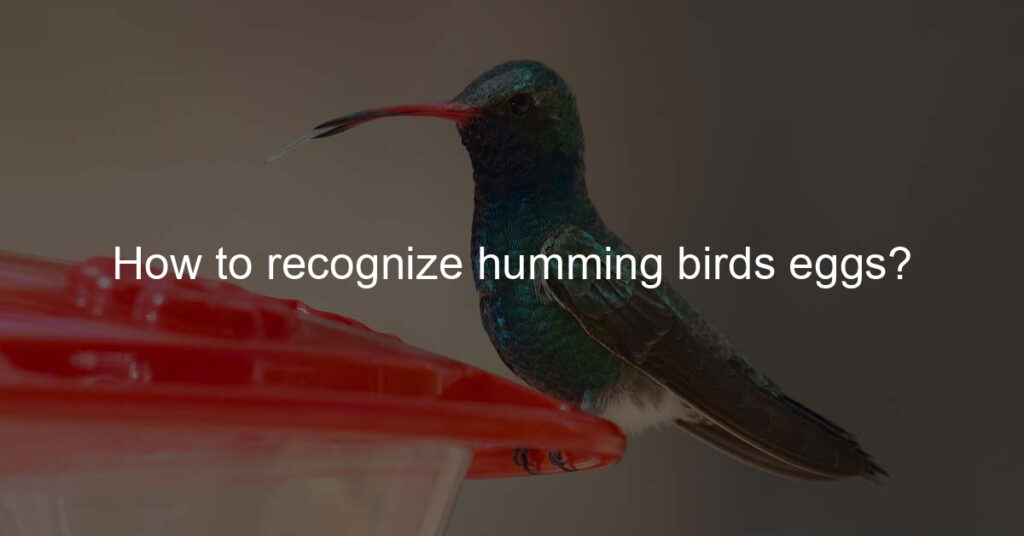If you’re a bird lover, you’ve probably spotted a hummingbird or two in your backyard. But did you know that these tiny birds lay eggs? Here’s how to recognize a hummingbird egg so you can add this species to your backyard birding list!
Hummingbird eggs are much larger than one might expect for such a small bird. In fact, their eggs typically measure around 6-7mm long and have a glossy surface. This is especially impressive when you consider that the size of a hummingbird itself averages between 3-5 inches!
When it comes to identifying these tiny eggs, one of the easiest ways to spot them is to look for a nest. Hummingbirds usually build their nests out of plant fibers and spider webs on branches or other structures close to the ground. The nest will likely be smaller than a teaspoon and contain two eggs at most.
What color are hummingbirds’ eggs?
Hummingbirds are beautiful creatures, and most people know that their feathers come in a wide variety of bright colors. But did you know that the eggs of hummingbirds can be a far more sedate and subtle color? Hummingbird eggs are generally pale white, cream, or pinkish-white, which is why they are so difficult to find amongst all those brightly-colored feathers!
The soft shade of the eggshells also serves as a great camouflage for fledglings after they’ve hatched, acting as an effective way to hide them from predators looking for a quick meal.
What color and size are hummingbird eggs?
Hummingbird eggs are among the smallest of all bird eggs, typically being no more than about 14 mm (0.55 in) long and 7 or 8 mm (0.28 to 0.31 in) wide. Surprisingly, considering their dainty size, they are a creamy white color. Though color variations may depend on the species of hummingbird, most types have eggs with a pale pinkish-white tint lingering around their shells.
This slight reddish hue is caused by pigments found within the female hummingbird’s bloodstream which transfer onto the eggshell as it’s forming to give it a unique look. It’s incredible that these almost invisible creatures lay such colorful eggs!
How do you identify an egg nest?
Identifying an egg nest can be tricky but ultimately very rewarding. The first thing you need to do is make sure that you’re looking in the right place at the right time of year. Once you have a location, examine its surroundings carefully and look for materials that might have been used by a bird to line the nest, such as twigs, grasses, feathers, and animal fur.
You should also look for eggs in various shades of blue, white, or brown depending on the species. Finally, listen closely for any sounds of chirping or singing coming from the general area – often times parent birds will give auditory clues about their presence. By using these simple steps you can easily identify an egg nest in your area.
What size are hummingbird eggs?
Hummingbirds lay some of the smallest eggs in the bird world. The eggs are typically around 1/4 to 3/8 inches long, making them about half the size of a nickel or smaller! Their nests are also proportionally minuscule, crafted with bits of moss and spiderwebs while lined with feathers and down.
Although they appear fragile, hummingbird eggs have a shell strength similar to other birds’ eggs because they are regulated to keep air loss at a minimum and protect the embryos inside. However, this means the incubation period is longer than most other birds – 14-16 days until babies make their grand entry into the world!
What to do if you find a hummingbird egg?
If you find a hummingbird egg, the most important thing is to leave it alone. The mother hummingbird carefully monitors her nest and will stay away if she senses any interference or disturbance. It is against the law to take any eggs from nests in most states and could be considered cruelty to animals in some cases.
Instead of trying to collect or move the egg, observe it from a distance and admire the beauty of these small birds. Hummingbird nests are often quite fragile, so do not attempt to touch them with bare hands. If you want to help out a family of hummingbirds, you can always create a hummingbird-friendly environment such as planting native flowers that attract them.
The Bottom Line
In conclusion, understanding the differences between hummingbird eggs and other birds’ eggs is essential to recognizing hummingbird eggs. The visual difference lies in size, with hummingbird eggs being significantly smaller than most other avian eggs. Texturally speaking, homeless have a glossy surface compared to other avian eggs which are duller.
Hummingbirds also tend to lay their egg in areas that are partially hidden by vegetation or materials like moss. Understanding these key characteristics is an important part of identifying hummingbird eggs in the wild, or if you ever get lucky enough to find one! With luck and some guidance you can easily recognize hummingbird eggs so keep your eyes peeled next time you’re out bird-watching!







